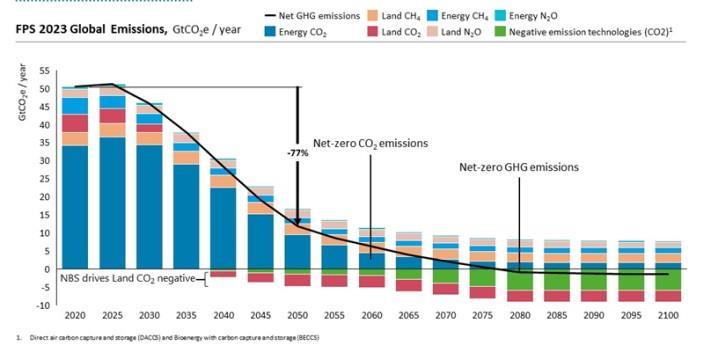
COP28: Changing global temperature target would dilute net zero strategies
Stewardship practices, especially escalation and divestment policies, will weaken if COP leaders opt for a 2C or 1.8C global temperature target, pension funds say
Changing the global temperature target from 1.5C to 1.8/2C will weaken net-zero-related engagements between investors and their investee companies, investors warn.
It will also increase physical risks and change risk management practices and investment strategies.
Ahead of the upcoming COP28 summit, asset owners face the challenge of how to navigate a situation where world leaders could abandon the 1.5C target as increasingly unrealistic.
“If COP leaders and/or the International Panel on Climate Change (IPCC) say that is no longer viable and change the recommendation, then the investment environment would undergo a material change. Investment strategies would also change to account for the moved goalposts" warns Ben Ward, a spokesperson for Nest.
Investments in renewables infrastructure, however, would likely remain unaffected. This is because a 2C or 1.8C temperature target, which effectively pushes back the net-zero deadline from 2050 to 2065/2070, would not change the long-term trajectory of the energy transition.
“Asset owners have aligned their net-zero strategies with a 1.5C transition,” said Ward.
Staying below 1.5C is widely considered essential to avoid the most damaging impacts of global heating.
When political leaders gathered in Paris in 2015, they agreed to keep the long-term rise in global temperatures this century "well below" 2C and to make every effort to keep it under 1.5C.
However, the IPCC recently signalled that 1.5C may no longer be viable. This has led investors to look to COP28 for signals about potential changes to the global temperature target, according to Ward. The conference is due to give a first “stocktake” of climate action under the Paris pact.
“Some investors may already be looking to switch to 2C,” Ward added.
Stewardship
“There is not much point in aligning your portfolio with 1.5C if the world isn't, because it would mean large-scale divestments,” said Katherina Lindmeier, senior responsible investment manager at NEST.
This is because delaying the transition by 15 or 20 years would allow corporates to delay their transition, enabling them to pollute for longer. Investors would either have to change their own targets to account for the delays and weaken engagements or divest from companies that shift to the 1.8/2C target.
Net Zero Investor's Annual Conference | 11th December 2023 | London
“It’s fair to highlight that changing the global temperature target would have a negative impact on stewardship,” said Shiventa Sivanesan, assistant director of investment management and stewardship at West Midlands Pension Fund. “This is where we need the collaboration of like-minded investors, financial institutions, advisors, policymakers. Everybody has a role to play.”
Sivanesan added that “education” – being clear on expectations for investee companies – is a really important part of how investors hold companies to account in relation to action and timely progress on emissions reduction.
Changing the temperature target wouldn’t have a “material impact” on West Midlands Pension Fund’s general approach and overall mission to reduce emissions in a way that aligns with their fiduciary duty.
“The number of companies that are actually aligned with a 1.5C scenario is already extremely low,” he warned. “It’s important to be realistic”.
Reducing emissions across investment portfolios is by no means a straightforward journey but “nonlinear and multifaceted”, with jumps and spikes along the way, particularly as data quality and coverage improves.
“Having a flexible and adaptable approach to take into account the latest best practice and evidence is important, but it doesn’t mean we should reduce our ambition,” he added.
There is not much point in aligning your portfolio with 1.5C if the world isn't, because it would mean large-scale divestments

Increased physical risk
Scientists have said crossing the 1.5C threshold risks unleashing far more severe climate change effects on people, wildlife and ecosystems. For example, heatwaves would become both more frequent and more severe.
An extreme heat event that occurred once per decade in a climate without human influence, would happen 4.1 times a decade at 1.5C of warming, and 5.6 times at 2C, according to the U.N. climate science panel (IPCC).
“We're very conscious that 1.5C is a better outcome for everyone, including our beneficiaries,” said Lindmeier.
The increased physical risk of a 2C scenario would not only reduce the quality of life for pensioners but also increase the financial risk surrounding the pension pot.
Will the target actually change?
Jakob Thomä, co-founder and research director at the think tank Theia Finance Labs, believes that the world will likely achieve the Paris Agreement goal of limiting temperature increase to “well below 2°C” and continue to make efforts towards 1.5C once temperatures peak, as recently forecasted by the Inevitable Policy Response (IPR).
He therefore sees little reason to suspect that the global temperature target will change to 2C, despite the various rumours.

The IPR forecast was informed by live tracking of over 300 climate policies over the past two years, as well as input from over 100 climate policy experts across 12 countries.
The real question for Thomä isn’t whether COP leaders will drop the 1.5C target but whether they will drop “efforts towards 1.5C”.
“This ambiguous wording could mean that COP leaders will let temperatures peak at 1.8C but then make efforts to bring it back to down to 1.5C through carbon removals,” he said.
A shift to 1.8C would still create considerable complications for the investment community, which has “honed in” on the 1.5C target. “I expect some investors would change their targets from 1.5C to well below 2C,” added Thomä.
In any case, Thomä argued that the global temperature target wouldn’t change this year for two main reasons.
Firstly, the reputational pressure to maintain 1.5C is still too high for politicians. Changing it would constitute a great political failure.
Secondly, The 2050 net zero goal is global and requires developed markets to be net zero 2040-2045. Even in a 1.8C world, developed markets should still be net zero (or close) by 2050, he emphasised.




